Submitted:
21 October 2024
Posted:
24 October 2024
You are already at the latest version
Abstract
Keywords:
1. Introduction
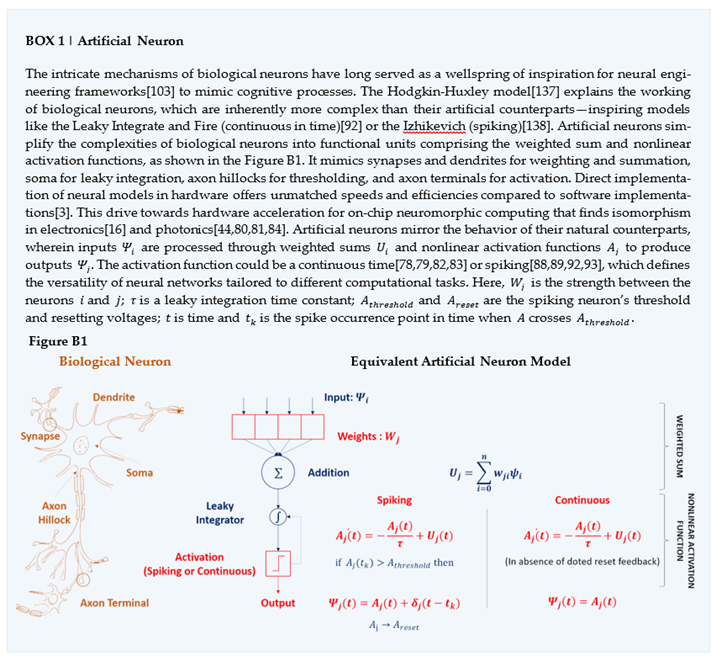
1.1 Neuromorphic Electronic Computing: On-Chip AI
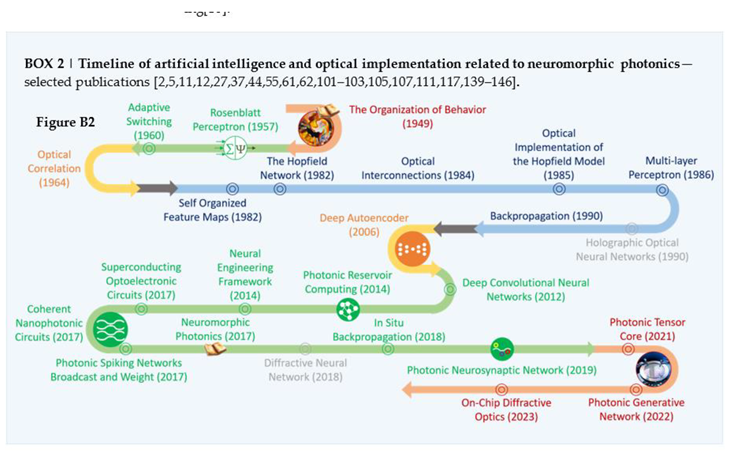
1.2. Photonics: A Solution Looking for a Problem!
1.3. Is Neuromorphic Photonics the Future of AI Technology?
2. Neuromorphic Photonics Processing Node
2.1. Neuromorphic Photonic Processing Node Architecture
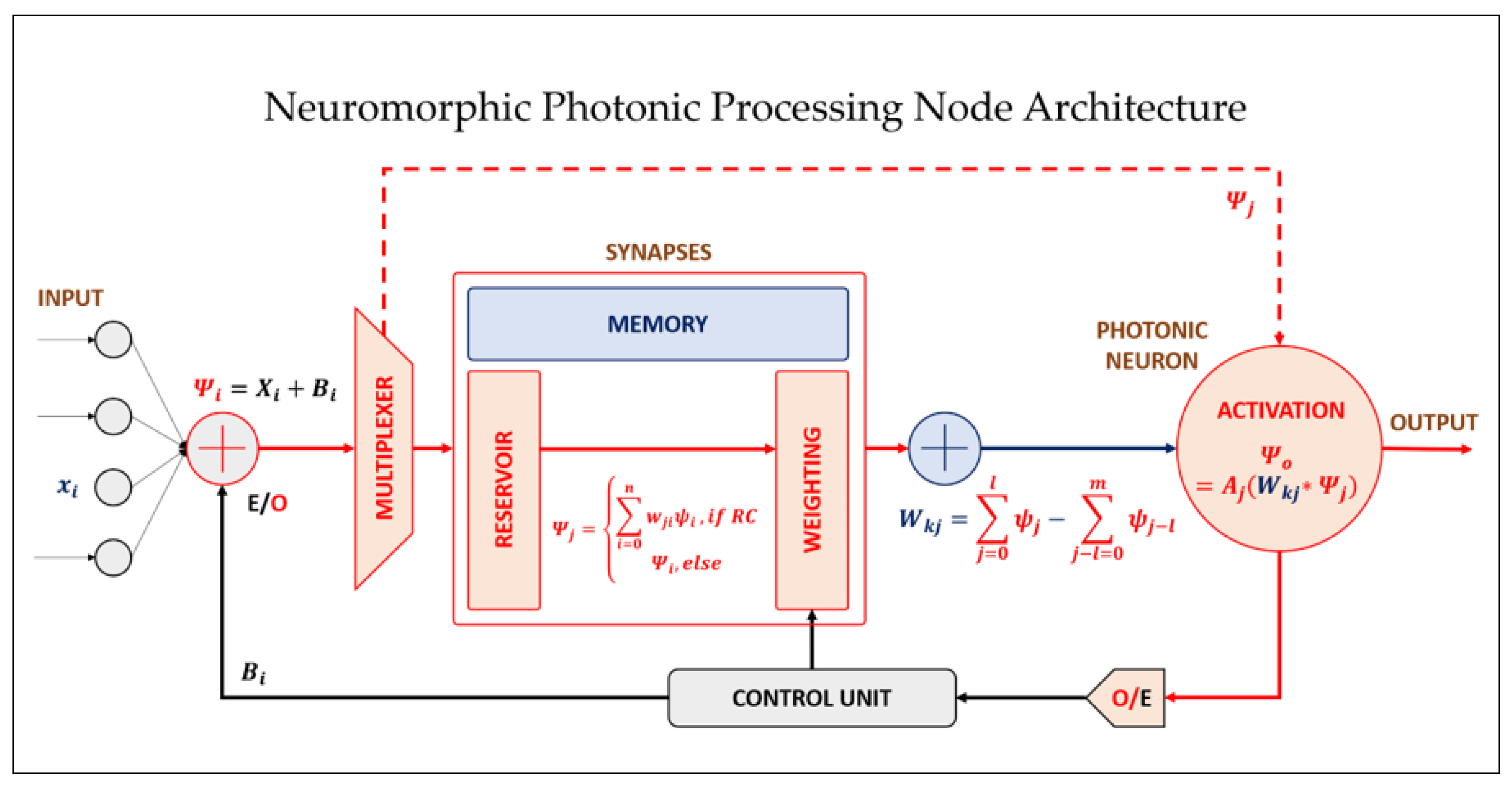
2.2. Weights (Synapses): Linear Operation
2.2. Nonlinear Activation (Photonic Neuron)
3. Neuromorphic Photonic Networks
3.1. Neuromorphic Photonic Network: A Proposed Architecture
- Instead of traditional convolutional layers, the RecConv-nPN employs NPPNs to perform convolutional operations directly on input photonic signals, enabling them to extract spatial features from the input data and apply nonlinear activation functions simultaneously.
- NPPNs in RC mode, followed by unit weighting within the synapse for pooling operations (Figure 1), eliminating the need for different variety of layers. NPPNs dynamically aggregate information across spatial dimensions of the input data, facilitating down sampling and feature selection while preserving the advantages of photonic processing.
- A defining feature of the RecConv-nPN is its incorporation of a recurrent feedback loop enabled by the inherent memory (synaptic or delayed) properties of NPPNs. The output from the post NPPNs is fed back into the pre NPPNs in the network, allowing for iterative refinement of representations over multiple time steps and capturing temporal dependencies in the input data.
- Following the recurrent processing stage, the output is flattened for processing (say classification). This final layer utilizes standard classification techniques to map the learned features to specific output classes, enabling the network to make accurate predictions based on the input data.
3.1. Neuromorphic Photonic Approaches
3.1. Algorithms and Methods for Training Neuromorphic Photonic Networks
4. Discussion
4.1. Exploring the Current State-of-the-Art: Challenges and Solutions
- a.
- Synergistic Co-the integration of Photonics with Electronics
- b.
- On-chip Light Sources on Silicon Platform
4.2. Advancements and Future Directions in Scientific Inquiry
- b.
- Fabrication Challenges
- c.
- Integration of Photonic Components
- c.
- Synaptic Memory
4.2. Envisioning the Future of Neuromorphic Photonics: A Visionary Perspective
5. Conclusion
Author Contributions
Funding
Institutional Review Board Statement
Informed Consent Statement
Data Availability Statement
Acknowledgments
Conflicts of Interest
References
- Batra. Gaurav; Jacobson, Z.; Madhav, S.; Queirolo, A.; Santhanam, N. Artificial-Intelligence Hardware: New Opportunities for Semiconductor Companies, High Tech, Dec. 2018.
- Rosenblatt, F. The Perceptron, a Perceiving and Recognizing Automaton Project Para; Cornell Aeronautical Laboratory, 1957;
- Nahmias, M.A.; de Lima, T.F.; Tait, A.N.; Peng, H.-T.; Shastri, B.J.; Prucnal, P.R. Photonic Multiply-Accumulate Operations for Neural Networks. IEEE Journal of Selected Topics in Quantum Electronics 2020, 26, 1–18. [Google Scholar] [CrossRef]
- Wetzstein, G.; Ozcan, A.; Gigan, S.; Fan, S.; Englund, D.; Soljačić, M.; Denz, C.; Miller, D.A.B.; Psaltis, D. Inference in Artificial Intelligence with Deep Optics and Photonics. Nature 2020, 588, 39–47. [Google Scholar] [CrossRef] [PubMed]
- Rumelhart, D.E.; Hinton, G.E.; Williams, R.J. Learning Representations by Back-Propagating Errors. Nature 1986, 323, 533–536. [Google Scholar] [CrossRef]
- LeCun, Y.; Bengio, Y.; Hinton, G. Deep Learning. Nature 2015, 521, 436–444. [Google Scholar] [CrossRef]
- Li, Z.; Liu, F.; Yang, W.; Peng, S.; Zhou, J. A Survey of Convolutional Neural Networks: Analysis, Applications, and Prospects. IEEE Trans Neural Netw Learn Syst 2022, 33, 6999–7019. [Google Scholar] [CrossRef]
- Choquette, J. NVIDIA Hopper H100 GPU: Scaling Performance. IEEE Micro 2023, 43, 9–17. [Google Scholar] [CrossRef]
- Yonghui Wu; Mike Schuster; Zhifeng Chen; Quoc V. Le; Mohammad Norouzi; Wolfgang Macherey Google’s Neural Machine Translation System: Bridging the Gap between Human and Machine Translation. arXiv preprint arXiv:1609.08144 2016, arXiv:1609.08144 2016.
- Huang, C.; Sorger, V.J.; Miscuglio, M.; Al-Qadasi, M.; Mukherjee, A.; Lampe, L.; Nichols, M.; Tait, A.N.; Ferreira de Lima, T.; Marquez, B.A.; et al. Prospects and Applications of Photonic Neural Networks. Adv Phys X 2022, 7. [Google Scholar] [CrossRef]
- LeCun, Y.; Boser, B.; Denker, J.; Henderson, D.; Howard, R.; Hubbard, W.; Jackel, L. Handwritten Digit Recognition with a Back-Propagation Network. Adv Neural Inf Process Syst 1989, 2. [Google Scholar]
- Hinton, G.E.; Salakhutdinov, R.R. Reducing the Dimensionality of Data with Neural Networks. Science (1979) 2006, 313, 504–507. [Google Scholar] [CrossRef]
- Capper, D.; Jones, D.T.W.; Sill, M.; Hovestadt, V.; Schrimpf, D.; Sturm, D.; Koelsche, C.; Sahm, F.; Chavez, L.; Reuss, D.E.; et al. DNA Methylation-Based Classification of Central Nervous System Tumours. Nature 2018, 555, 469–474. [Google Scholar] [CrossRef] [PubMed]
- Shekhar, S.; Bogaerts, W.; Chrostowski, L.; Bowers, J.E.; Hochberg, M.; Soref, R.; Shastri, B.J. Roadmapping the next Generation of Silicon Photonics. Nat Commun 2024, 15, 751. [Google Scholar] [CrossRef] [PubMed]
- Berggren, K.; Xia, Q.; Likharev, K.K.; Strukov, D.B.; Jiang, H.; Mikolajick, T.; Querlioz, D.; Salinga, M.; Erickson, J.R.; Pi, S.; et al. Roadmap on Emerging Hardware and Technology for Machine Learning. Nanotechnology 2021, 32, 012002. [Google Scholar] [CrossRef] [PubMed]
- Merolla, P.A.; Arthur, J. V.; Alvarez-Icaza, R.; Cassidy, A.S.; Sawada, J.; Akopyan, F.; Jackson, B.L.; Imam, N.; Guo, C.; Nakamura, Y.; et al. A Million Spiking-Neuron Integrated Circuit with a Scalable Communication Network and Interface. Science (1979) 2014, 345, 668–673. [Google Scholar] [CrossRef]
- Furber, S.B.; Galluppi, F.; Temple, S.; Plana, L.A. The SpiNNaker Project. Proceedings of the IEEE 2014, 102, 652–665. [Google Scholar] [CrossRef]
- Davies, M.; Srinivasa, N.; Lin, T.-H.; Chinya, G.; Cao, Y.; Choday, S.H.; Dimou, G.; Joshi, P.; Imam, N.; Jain, S.; et al. Loihi: A Neuromorphic Manycore Processor with On-Chip Learning. IEEE Micro 2018, 38, 82–99. [Google Scholar] [CrossRef]
- Benjamin, B.V.; Gao, P.; McQuinn, E.; Choudhary, S.; Chandrasekaran, A.R.; Bussat, J.-M.; Alvarez-Icaza, R.; Arthur, J. V.; Merolla, P.A.; Boahen, K. Neurogrid: A Mixed-Analog-Digital Multichip System for Large-Scale Neural Simulations. Proceedings of the IEEE 2014, 102, 699–716. [Google Scholar] [CrossRef]
- Goodman, J.W. Fan-in and Fan-out with Optical Interconnections. Optica Acta: International Journal of Optics 1985, 32, 1489–1496. [Google Scholar] [CrossRef]
- Sawada, J.; Akopyan, F.; Cassidy, A.S.; Taba, B.; Debole, M. V.; Datta, P.; Alvarez-Icaza, R.; Amir, A.; Arthur, J. V.; Andreopoulos, A.; et al. TrueNorth Ecosystem for Brain-Inspired Computing: Scalable Systems, Software, and Applications. In Proceedings of the SC16: International Conference for High Performance Computing, Networking, Storage and Analysis; IEEE, November 2016; pp. 130–141.
- Pei, J.; Deng, L.; Song, S.; Zhao, M.; Zhang, Y.; Wu, S.; Wang, G.; Zou, Z.; Wu, Z.; He, W.; et al. Towards Artificial General Intelligence with Hybrid Tianjic Chip Architecture. Nature 2019, 572, 106–111. [Google Scholar] [CrossRef]
- Jake Siegel With a Systems Approach to Chips, Microsoft Aims to Tailor Everything ‘from Silicon to Service’ to Meet AI Demand.
- Miller, D.A.B. Rationale and Challenges for Optical Interconnects to Electronic Chips. Proceedings of the IEEE 2000, 88, 728–749. [Google Scholar] [CrossRef]
- Nozaki, K.; Matsuo, S.; Fujii, T.; Takeda, K.; Shinya, A.; Kuramochi, E.; Notomi, M. Femtofarad Optoelectronic Integration Demonstrating Energy-Saving Signal Conversion and Nonlinear Functions. Nat Photonics 2019, 13, 454–459. [Google Scholar] [CrossRef]
- Han, J.; Jentzen, A.; E, W. Solving High-Dimensional Partial Differential Equations Using Deep Learning. Proceedings of the National Academy of Sciences 2018, 115, 8505–8510. [Google Scholar] [CrossRef] [PubMed]
- Hughes, T.W.; Minkov, M.; Shi, Y.; Fan, S. Training of Photonic Neural Networks through in Situ Backpropagation and Gradient Measurement. Optica 2018, 5, 864. [Google Scholar] [CrossRef]
- Tait, A.N.; Ma, P.Y.; Ferreira de Lima, T.; Blow, E.C.; Chang, M.P.; Nahmias, M.A.; Shastri, B.J.; Prucnal, P.R. Demonstration of Multivariate Photonics: Blind Dimensionality Reduction With Integrated Photonics. Journal of Lightwave Technology 2019, 37, 5996–6006. [Google Scholar] [CrossRef]
- Markram, H. The Human Brain Project. Sci Am 2012, 306, 50–55. [Google Scholar] [CrossRef]
- Josh Achiam; Steven Adler; Sandhini Agarwal; Lama Ahmad; Ilge Akkaya; et. al. GPT-4 Technical Report. ArXiv 2023, 1–100.
- Tesla Dojo Technology A Guide to Tesla’s Configurable Floating Point Formats & Arithmetic. Available online: https://digitalassets.tesla.com/tesla-contents/image/upload/tesla-dojo-technology.pdf (accessed on 1 March 2024).
- Goodman, J.W.; Dias, A.R.; Woody, L.M. Fully Parallel, High-Speed Incoherent Optical Method for Performing Discrete Fourier Transforms. Opt Lett 1978, 2, 1. [Google Scholar] [CrossRef]
- Keyes, R.W. Optical Logic-in the Light of Computer Technology. Optica Acta: International Journal of Optics 1985, 32, 525–535. [Google Scholar] [CrossRef]
- Patel, D.; Ghosh, S.; Chagnon, M.; Samani, A.; Veerasubramanian, V.; Osman, M.; Plant, D. V. Design, Analysis, and Transmission System Performance of a 41 GHz Silicon Photonic Modulator. Opt Express 2015, 23, 14263. [Google Scholar] [CrossRef]
- Argyris, A. Photonic Neuromorphic Technologies in Optical Communications. Nanophotonics 2022, 11, 897–916. [Google Scholar] [CrossRef]
- Shastri, B.J.; Tait, A.N.; Ferreira de Lima, T.; Pernice, W.H.P.; Bhaskaran, H.; Wright, C.D.; Prucnal, P.R. Photonics for Artificial Intelligence and Neuromorphic Computing. Nat Photonics 2021, 15, 102–114. [Google Scholar] [CrossRef]
- Nahmias, M.A.; Shastri, B.J.; Tait, A.N.; Ferreira De Lima, T.; Prucnal, P.R. Neuromorphic Photonics; 2018.
- Zhou, H.; Dong, J.; Cheng, J.; Dong, W.; Huang, C.; Shen, Y.; Zhang, Q.; Gu, M.; Qian, C.; Chen, H.; et al. Photonic Matrix Multiplication Lights up Photonic Accelerator and Beyond. Light Sci Appl 2022, 11. [Google Scholar] [CrossRef] [PubMed]
- Carolan, J.; Harrold, C.; Sparrow, C.; Martín-López, E.; Russell, N.J.; Silverstone, J.W.; Shadbolt, P.J.; Matsuda, N.; Oguma, M.; Itoh, M.; et al. Universal Linear Optics. Science (1979) 2015, 349, 711–716. [Google Scholar] [CrossRef] [PubMed]
- Maryam Moridsadat; Marcus Tamura; Lukas Chrostowski; Sudip Shekhar; Bhavin J. Shastri Design Methodology for Silicon Organic Hybrid Modulators: From Physics to System-Level Modeling. ArXiv 2024, 1–16.
- Gaeta, A.L.; Lipson, M.; Kippenberg, T.J. Photonic-Chip-Based Frequency Combs. Nat Photonics 2019, 13, 158–169. [Google Scholar] [CrossRef]
- Xavier, J.; Probst, J.; Becker, C. Deterministic Composite Nanophotonic Lattices in Large Area for Broadband Applications. Sci Rep 2016, 6. [Google Scholar] [CrossRef]
- Xavier, J.; Probst, J.; Back, F.; Wyss, P.; Eisenhauer, D.; Löchel, B.; Rudigier-Voigt, E.; Becker, C. Quasicrystalline-Structured Light Harvesting Nanophotonic Silicon Films on Nanoimprinted Glass for Ultra-Thin Photovoltaics. Opt Mater Express 2014, 4, 2290. [Google Scholar] [CrossRef]
- Feldmann, J.; Youngblood, N.; Wright, C.D.; Bhaskaran, H.; Pernice, W.H.P. All-Optical Spiking Neurosynaptic Networks with Self-Learning Capabilities. Nature 2019, 569, 208–214. [Google Scholar] [CrossRef]
- Stojanović, V.; Ram, R.J.; Popović, M.; Lin, S.; Moazeni, S.; Wade, M.; Sun, C.; Alloatti, L.; Atabaki, A.; Pavanello, F.; et al. Monolithic Silicon-Photonic Platforms in State-of-the-Art CMOS SOI Processes [Invited]. Opt Express 2018, 26, 13106. [Google Scholar] [CrossRef]
- Sun, C.; Wade, M.T.; Lee, Y.; Orcutt, J.S.; Alloatti, L.; Georgas, M.S.; Waterman, A.S.; Shainline, J.M.; Avizienis, R.R.; Lin, S.; et al. Single-Chip Microprocessor That Communicates Directly Using Light. Nature 2015, 528, 534–538. [Google Scholar] [CrossRef]
- Bogaerts, W.; Chrostowski, L. Silicon Photonics Circuit Design: Methods, Tools and Challenges. Laser Photon Rev 2018, 12. [Google Scholar] [CrossRef]
- Tait, A.N.; De Lima, T.F.; Nahmias, M.A.; Shastri, B.J.; Prucnal, P.R. Continuous Calibration of Microring Weights for Analog Optical Networks. IEEE Photonics Technology Letters 2016, 28, 887–890. [Google Scholar] [CrossRef]
- de Lima, T.F.; Peng, H.-T.; Tait, A.N.; Nahmias, M.A.; Miller, H.B.; Shastri, B.J.; Prucnal, P.R. Machine Learning With Neuromorphic Photonics. Journal of Lightwave Technology 2019, 37, 1515–1534. [Google Scholar] [CrossRef]
- Ríos, C.; Youngblood, N.; Cheng, Z.; Le Gallo, M.; Pernice, W.H.P.; Wright, C.D.; Sebastian, A.; Bhaskaran, H. In-Memory Computing on a Photonic Platform. Sci Adv 2019, 5. [Google Scholar] [CrossRef] [PubMed]
- Rios, C.; Stegmaier, M.; Hosseini, P.; Wang, D.; Scherer, T.; Wright, C.D.; Bhaskaran, H.; Pernice, W.H.P. Integrated All-Photonic Non-Volatile Multi-Level Memory. Nat Photonics 2015, 9, 725–732. [Google Scholar] [CrossRef]
- Cheng, Z.; Ríos, C.; Pernice, W.H.P.; Wright, C.D.; Bhaskaran, H. On-Chip Photonic Synapse. Sci Adv 2017, 3. [Google Scholar] [CrossRef]
- James Betker; Gabriel Goh; Li Jing; Tim Brooks; Jianfeng Wang; Linjie Li; Long Ouyang; Juntang Zhuang; Joyce Lee; Yufei Guo; et al. Improving Image Generation with Better Captions. Available online: https://cdn.openai.com/papers/dall-e-3.pdf (accessed on 25 February 2024).
- Xu, B.; Huang, Y.; Fang, Y.; Wang, Z.; Yu, S.; Xu, R. Recent Progress of Neuromorphic Computing Based on Silicon Photonics: Electronic–Photonic Co-Design, Device, and Architecture. Photonics 2022, 9. [Google Scholar] [CrossRef]
- Farhat, N.H.; Psaltis, D.; Prata, A.; Paek, E. Optical Implementation of the Hopfield Model. Appl Opt 1985, 24, 1469. [Google Scholar] [CrossRef]
- Bai, Y.; Xu, X.; Tan, M.; Sun, Y.; Li, Y.; Wu, J.; Morandotti, R.; Mitchell, A.; Xu, K.; Moss, D.J. Photonic Multiplexing Techniques for Neuromorphic Computing. Nanophotonics 2023, 12, 795–817. [Google Scholar] [CrossRef]
- Marković, D.; Mizrahi, A.; Querlioz, D.; Grollier, J. Physics for Neuromorphic Computing. Nature Reviews Physics 2020, 2, 499–510. [Google Scholar] [CrossRef]
- Jaeger, H.; Haas, H. Harnessing Nonlinearity: Predicting Chaotic Systems and Saving Energy in Wireless Communication. Science (1979) 2004, 304, 78–80. [Google Scholar] [CrossRef] [PubMed]
- Maass, W. Networks of Spiking Neurons: The Third Generation of Neural Network Models. Neural Networks 1997, 10, 1659–1671. [Google Scholar] [CrossRef]
- Song, S.; Miller, K.D.; Abbott, L.F. Competitive Hebbian Learning through Spike-Timing-Dependent Synaptic Plasticity. Nat Neurosci 2000, 3, 919–926. [Google Scholar] [CrossRef] [PubMed]
- Vandoorne, K.; Mechet, P.; Van Vaerenbergh, T.; Fiers, M.; Morthier, G.; Verstraeten, D.; Schrauwen, B.; Dambre, J.; Bienstman, P. Experimental Demonstration of Reservoir Computing on a Silicon Photonics Chip. Nat Commun 2014, 5. [Google Scholar] [CrossRef]
- Shen, Y.; Harris, N.C.; Skirlo, S.; Prabhu, M.; Baehr-Jones, T.; Hochberg, M.; Sun, X.; Zhao, S.; Larochelle, H.; Englund, D.; et al. Deep Learning with Coherent Nanophotonic Circuits. Nat Photonics 2017, 11, 441–446. [Google Scholar] [CrossRef]
- Reck, M.; Zeilinger, A.; Bernstein, H.J.; Bertani, P. Experimental Realization of Any Discrete Unitary Operator. Phys Rev Lett 1994, 73, 58–61. [Google Scholar] [CrossRef]
- Chiles, J.; Buckley, S.M.; Nam, S.W.; Mirin, R.P.; Shainline, J.M. Design, Fabrication, and Metrology of 10 × 100 Multi-Planar Integrated Photonic Routing Manifolds for Neural Networks. APL Photonics 2018, 3. [Google Scholar] [CrossRef]
- Jayatilleka, H.; Murray, K.; Guillén-Torres, M.Á.; Caverley, M.; Hu, R.; Jaeger, N.A.F.; Chrostowski, L.; Shekhar, S. Wavelength Tuning and Stabilization of Microring-Based Filters Using Silicon in-Resonator Photoconductive Heaters. Opt Express 2015, 23, 25084. [Google Scholar] [CrossRef]
- Tait, A.N.; Jayatilleka, H.; De Lima, T.F.; Ma, P.Y.; Nahmias, M.A.; Shastri, B.J.; Shekhar, S.; Chrostowski, L.; Prucnal, P.R. Feedback Control for Microring Weight Banks. Opt Express 2018, 26, 26422. [Google Scholar] [CrossRef]
- Bogaerts, W.; De Heyn, P.; Van Vaerenbergh, T.; De Vos, K.; Kumar Selvaraja, S.; Claes, T.; Dumon, P.; Bienstman, P.; Van Thourhout, D.; Baets, R. Silicon Microring Resonators. Laser Photon Rev 2012, 6, 47–73. [Google Scholar] [CrossRef]
- Tait, A.N.; Wu, A.X.; De Lima, T.F.; Zhou, E.; Shastri, B.J.; Nahmias, M.A.; Prucnal, P.R. Microring Weight Banks. IEEE Journal of Selected Topics in Quantum Electronics 2016, 22, 312–325. [Google Scholar] [CrossRef]
- Shi, B.; Calabretta, N.; Stabile, R. Deep Neural Network Through an InP SOA-Based Photonic Integrated Cross-Connect. IEEE Journal of Selected Topics in Quantum Electronics 2020, 26, 1–11. [Google Scholar] [CrossRef]
- Brunner, D.; Soriano, M.C.; Mirasso, C.R.; Fischer, I. Parallel Photonic Information Processing at Gigabyte per Second Data Rates Using Transient States. Nat Commun 2013, 4. [Google Scholar] [CrossRef]
- Gholipour, B.; Bastock, P.; Craig, C.; Khan, K.; Hewak, D.; Soci, C. Amorphous Metal-Sulphide Microfibers Enable Photonic Synapses for Brain-Like Computing. Adv Opt Mater 2015, 3, 635–641. [Google Scholar] [CrossRef]
- Komljenovic, T.; Davenport, M.; Hulme, J.; Liu, A.Y.; Santis, C.T.; Spott, A.; Srinivasan, S.; Stanton, E.J.; Zhang, C.; Bowers, J.E. Heterogeneous Silicon Photonic Integrated Circuits. Journal of Lightwave Technology 2016, 34, 20–35. [Google Scholar] [CrossRef]
- Wang, Y.; Lv, Z.; Chen, J.; Wang, Z.; Zhou, Y.; Zhou, L.; Chen, X.; Han, S. Photonic Synapses Based on Inorganic Perovskite Quantum Dots for Neuromorphic Computing. Advanced Materials 2018, 30. [Google Scholar] [CrossRef]
- Sorianello, V.; Midrio, M.; Contestabile, G.; Asselberghs, I.; Van Campenhout, J.; Huyghebaert, C.; Goykhman, I.; Ott, A.K.; Ferrari, A.C.; Romagnoli, M. Graphene–Silicon Phase Modulators with Gigahertz Bandwidth. Nat Photonics 2018, 12, 40–44. [Google Scholar] [CrossRef]
- Bangari, V.; Marquez, B.A.; Miller, H.; Tait, A.N.; Nahmias, M.A.; de Lima, T.F.; Peng, H.-T.; Prucnal, P.R.; Shastri, B.J. Digital Electronics and Analog Photonics for Convolutional Neural Networks (DEAP-CNNs). IEEE Journal of Selected Topics in Quantum Electronics 2020, 26, 1–13. [Google Scholar] [CrossRef]
- He, M.; Xu, M.; Ren, Y.; Jian, J.; Ruan, Z.; Xu, Y.; Gao, S.; Sun, S.; Wen, X.; Zhou, L.; et al. High-Performance Hybrid Silicon and Lithium Niobate Mach–Zehnder Modulators for 100 Gbit S−1 and Beyond. Nat Photonics 2019, 13, 359–364. [Google Scholar] [CrossRef]
- Harris, N.C.; Ma, Y.; Mower, J.; Baehr-Jones, T.; Englund, D.; Hochberg, M.; Galland, C. Efficient, Compact and Low Loss Thermo-Optic Phase Shifter in Silicon. Opt Express 2014, 22, 10487. [Google Scholar] [CrossRef]
- Rosenbluth, D.; Kravtsov, K.; Fok, M.P.; Prucnal, P.R. A High Performance Pulse Processing Device. Opt Express 2009, 17, 22767. [Google Scholar] [CrossRef] [PubMed]
- McCaughan, A.N.; Verma, V.B.; Buckley, S.M.; Allmaras, J.P.; Kozorezov, A.G.; Tait, A.N.; Nam, S.W.; Shainline, J.M. A Superconducting Thermal Switch with Ultrahigh Impedance for Interfacing Superconductors to Semiconductors. Nat Electron 2019, 2, 451–456. [Google Scholar] [CrossRef] [PubMed]
- Buckley, S.; Chiles, J.; McCaughan, A.N.; Moody, G.; Silverman, K.L.; Stevens, M.J.; Mirin, R.P.; Nam, S.W.; Shainline, J.M. All-Silicon Light-Emitting Diodes Waveguide-Integrated with Superconducting Single-Photon Detectors. Appl Phys Lett 2017, 111. [Google Scholar] [CrossRef] [PubMed]
- Williamson, I.A.D.; Hughes, T.W.; Minkov, M.; Bartlett, B.; Pai, S.; Fan, S. Reprogrammable Electro-Optic Nonlinear Activation Functions for Optical Neural Networks. IEEE Journal of Selected Topics in Quantum Electronics 2020, 26, 1–12. [Google Scholar] [CrossRef]
- Amin, R.; George, J.K.; Sun, S.; Ferreira de Lima, T.; Tait, A.N.; Khurgin, J.B.; Miscuglio, M.; Shastri, B.J.; Prucnal, P.R.; El-Ghazawi, T.; et al. ITO-Based Electro-Absorption Modulator for Photonic Neural Activation Function. APL Mater 2019, 7. [Google Scholar] [CrossRef]
- Nahmias, M.A.; Tait, A.N.; Tolias, L.; Chang, M.P.; Ferreira de Lima, T.; Shastri, B.J.; Prucnal, P.R. An Integrated Analog O/E/O Link for Multi-Channel Laser Neurons. Appl Phys Lett 2016, 108. [Google Scholar] [CrossRef]
- Tait, A.N.; Ferreira De Lima, T.; Nahmias, M.A.; Miller, H.B.; Peng, H.T.; Shastri, B.J.; Prucnal, P.R. Silicon Photonic Modulator Neuron. Phys Rev Appl 2019, 11. [Google Scholar] [CrossRef]
- Hill, M.T.; Frietman, E.E.E.; de Waardt, H.; Giok-djan Khoe; Dorren, H. J.S. All Fiber-Optic Neural Network Using Coupled SOA Based Ring Lasers. IEEE Trans Neural Netw 2002, 13, 1504–1513. [Google Scholar] [CrossRef]
- Beri, S.; Mashall, L.; Gelens, L.; Van der Sande, G.; Mezosi, G.; Sorel, M.; Danckaert, J.; Verschaffelt, G. Excitability in Optical Systems Close to -Symmetry. Phys Lett A 2010, 374, 739–743. [Google Scholar] [CrossRef]
- Gelens, L.; Mashal, L.; Beri, S.; Coomans, W.; Van der Sande, G.; Danckaert, J.; Verschaffelt, G. Excitability in Semiconductor Microring Lasers: Experimental and Theoretical Pulse Characterization. Phys Rev A (Coll Park) 2010, 82, 063841. [Google Scholar] [CrossRef]
- Coomans, W.; Gelens, L.; Beri, S.; Danckaert, J.; Van der Sande, G. Solitary and Coupled Semiconductor Ring Lasers as Optical Spiking Neurons. Phys Rev E 2011, 84, 036209. [Google Scholar] [CrossRef] [PubMed]
- Brunstein, M.; Yacomotti, A.M.; Sagnes, I.; Raineri, F.; Bigot, L.; Levenson, A. Excitability and Self-Pulsing in a Photonic Crystal Nanocavity. Phys Rev A (Coll Park) 2012, 85, 031803. [Google Scholar] [CrossRef]
- Shastri, B.J.; Nahmias, M.A.; Tait, A.N.; Rodriguez, A.W.; Wu, B.; Prucnal, P.R. Spike Processing with a Graphene Excitable Laser. Sci Rep 2016, 6. [Google Scholar] [CrossRef] [PubMed]
- Selmi, F.; Braive, R.; Beaudoin, G.; Sagnes, I.; Kuszelewicz, R.; Barbay, S. Relative Refractory Period in an Excitable Semiconductor Laser. Phys Rev Lett 2014, 112, 183902. [Google Scholar] [CrossRef]
- Nahmias, M.A.; Shastri, B.J.; Tait, A.N.; Prucnal, P.R. A Leaky Integrate-and-Fire Laser Neuron for Ultrafast Cognitive Computing. IEEE Journal of Selected Topics in Quantum Electronics 2013, 19, 1–12. [Google Scholar] [CrossRef]
- Romeira, B.; Javaloyes, J.; Ironside, C.N.; Figueiredo, J.M.L.; Balle, S.; Piro, O. Excitability and Optical Pulse Generation in Semiconductor Lasers Driven by Resonant Tunneling Diode Photo-Detectors. Opt Express 2013, 21, 20931. [Google Scholar] [CrossRef]
- Peng, H.T.; Nahmias, M.A.; De Lima, T.F.; Tait, A.N.; Shastri, B.J.; Prucnal, P.R. Neuromorphic Photonic Integrated Circuits. IEEE Journal of Selected Topics in Quantum Electronics 2018, 24. [Google Scholar] [CrossRef]
- Gupta, S.; Gahlot, S.; Roy, S. Design of Optoelectronic Computing Circuits with VCSEL-SA Based Neuromorphic Photonic Spiking. Optik (Stuttg) 2021, 243. [Google Scholar] [CrossRef]
- Xu, X.; Ren, G.; Feleppa, T.; Liu, X.; Boes, A.; Mitchell, A.; Lowery, A.J. Self-Calibrating Programmable Photonic Integrated Circuits. Nat Photonics 2022, 16, 595–602. [Google Scholar] [CrossRef]
- Hamerly, R.; Bandyopadhyay, S.; Englund, D. Asymptotically Fault-Tolerant Programmable Photonics. Nat Commun 2022, 13, 6831. [Google Scholar] [CrossRef]
- Yu Emma Wang; Gu-Yeon Wei; David Brooks Benchmarking TPU, GPU, and CPU Platforms for Deep Learning. ArXiv 2019, 4.
- Davies, M. Benchmarks for Progress in Neuromorphic Computing. Nat Mach Intell 2019, 1, 386–388. [Google Scholar] [CrossRef]
- Xiang, S.; Han, Y.; Song, Z.; Guo, X.; Zhang, Y.; Ren, Z.; Wang, S.; Ma, Y.; Zou, W.; Ma, B.; et al. A Review: Photonics Devices, Architectures, and Algorithms for Optical Neural Computing. Journal of Semiconductors 2021, 42. [Google Scholar] [CrossRef]
- Krizhevsky, A.; Sutskever, I.; Hinton, G.E. Imagenet Classification with Deep Convolutional Neural Networks. Adv Neural Inf Process Syst 2012, 25. [Google Scholar] [CrossRef]
- Tait, A.N.; De Lima, T.F.; Zhou, E.; Wu, A.X.; Nahmias, M.A.; Shastri, B.J.; Prucnal, P.R. Neuromorphic Photonic Networks Using Silicon Photonic Weight Banks. Sci Rep 2017, 7. [Google Scholar] [CrossRef]
- Stewart, T.C.; Eliasmith, C. Large-Scale Synthesis of Functional Spiking Neural Circuits. Proceedings of the IEEE 2014, 102, 881–898. [Google Scholar] [CrossRef]
- Dong, B.; Aggarwal, S.; Zhou, W.; Ali, U.E.; Farmakidis, N.; Lee, J.S.; He, Y.; Li, X.; Kwong, D.-L.; Wright, C.D.; et al. Higher-Dimensional Processing Using a Photonic Tensor Core with Continuous-Time Data. Nat Photonics 2023, 17, 1080–1088. [Google Scholar] [CrossRef]
- Feldmann, J.; Youngblood, N.; Karpov, M.; Gehring, H.; Li, X.; Stappers, M.; Le Gallo, M.; Fu, X.; Lukashchuk, A.; Raja, A.S.; et al. Parallel Convolutional Processing Using an Integrated Photonic Tensor Core. Nature 2021, 589, 52–58. [Google Scholar] [CrossRef]
- Bueno, J.; Maktoobi, S.; Froehly, L.; Fischer, I.; Jacquot, M.; Larger, L.; Brunner, D. Reinforcement Learning in a Large-Scale Photonic Recurrent Neural Network. Optica 2018, 5, 756. [Google Scholar] [CrossRef]
- Fu, T.; Zang, Y.; Huang, Y.; Du, Z.; Huang, H.; Hu, C.; Chen, M.; Yang, S.; Chen, H. Photonic Machine Learning with On-Chip Diffractive Optics. Nat Commun 2023, 14, 70. [Google Scholar] [CrossRef]
- Freiberger, M.; Katumba, A.; Bienstman, P.; Dambre, J. Training Passive Photonic Reservoirs With Integrated Optical Readout. IEEE Trans Neural Netw Learn Syst 2019, 30, 1943–1953. [Google Scholar] [CrossRef] [PubMed]
- Boshgazi, S.; Jabbari, A.; Mehrany, K.; Memarian, M. Virtual Reservoir Computer Using an Optical Resonator. Opt Mater Express 2022, 12, 1140. [Google Scholar] [CrossRef]
- Duport, F.; Schneider, B.; Smerieri, A.; Haelterman, M.; Massar, S. All-Optical Reservoir Computing. Opt Express 2012, 20, 22783. [Google Scholar] [CrossRef]
- Shainline, J.M.; Buckley, S.M.; Mirin, R.P.; Nam, S.W. Superconducting Optoelectronic Circuits for Neuromorphic Computing. Phys Rev Appl 2017, 7. [Google Scholar] [CrossRef]
- Shainline, J.M.; Buckley, S.M.; McCaughan, A.N.; Chiles, J.T.; Jafari Salim, A.; Castellanos-Beltran, M.; Donnelly, C.A.; Schneider, M.L.; Mirin, R.P.; Nam, S.W. Superconducting Optoelectronic Loop Neurons. J Appl Phys 2019, 126. [Google Scholar] [CrossRef]
- Xu, S.; Wang, J.; Wang, R.; Chen, J.; Zou, W. High-Accuracy Optical Convolution Unit Architecture for Convolutional Neural Networks by Cascaded Acousto-Optical Modulator Arrays. Opt Express 2019, 27, 19778. [Google Scholar] [CrossRef]
- Zhang, H.; Gu, M.; Jiang, X.D.; Thompson, J.; Cai, H.; Paesani, S.; Santagati, R.; Laing, A.; Zhang, Y.; Yung, M.H.; et al. An Optical Neural Chip for Implementing Complex-Valued Neural Network. Nat Commun 2021, 12, 457. [Google Scholar] [CrossRef]
- Zhu, H.H.; Zou, J.; Zhang, H.; Shi, Y.Z.; Luo, S.B.; Wang, N.; Cai, H.; Wan, L.X.; Wang, B.; Jiang, X.D.; et al. Space-Efficient Optical Computing with an Integrated Chip Diffractive Neural Network. Nat Commun 2022, 13, 1044. [Google Scholar] [CrossRef]
- Tait, A.N.; de Lima, T.F.; Nahmias, M.A.; Shastri, B.J.; Prucnal, P.R. Multi-Channel Control for Microring Weight Banks. Opt Express 2016, 24, 8895. [Google Scholar] [CrossRef]
- Wu, C.; Yang, X.; Yu, H.; Peng, R.; Takeuchi, I.; Chen, Y.; Li, M. Harnessing Optoelectronic Noises in a Photonic Generative Network. Sci Adv 2022, 8. [Google Scholar] [CrossRef]
- Roques-Carmes, C.; Shen, Y.; Zanoci, C.; Prabhu, M.; Atieh, F.; Jing, L.; Dubček, T.; Mao, C.; Johnson, M.R.; Čeperić, V.; et al. Heuristic Recurrent Algorithms for Photonic Ising Machines. Nat Commun 2020, 11, 249. [Google Scholar] [CrossRef] [PubMed]
- Zhang, T.; Wang, J.; Dan, Y.; Lanqiu, Y.; Dai, J.; Han, X.; Sun, X.; Xu, K. Efficient Training and Design of Photonic Neural Network through Neuroevolution. Opt Express 2019, 27, 37150. [Google Scholar] [CrossRef] [PubMed]
- Antonik, P.; Marsal, N.; Brunner, D.; Rontani, D. Bayesian Optimisation of Large-Scale Photonic Reservoir Computers. Cognit Comput 2023, 15, 1452–1460. [Google Scholar] [CrossRef]
- Scellier, B.; Bengio, Y. Equilibrium Propagation: Bridging the Gap between Energy-Based Models and Backpropagation. Front Comput Neurosci 2017, 11. [Google Scholar] [CrossRef]
- Tengji Xu; Weipeng Zhang; Jiawei Zhang; Zeyu Luo; Qiarong Xiao; Benshan Wang; Mingcheng Luo; Xingyuan Xu; Bhavin J. Shastri; Paul R. Prucnal; et al. Control-Free and Efficient Silicon Photonic Neural Networks via Hardware-Aware Training and Pruning. ArXiv 2024, 1–17.
- Xu, S.; Wang, J.; Yi, S.; Zou, W. High-Order Tensor Flow Processing Using Integrated Photonic Circuits. Nat Commun 2022, 13, 7970. [Google Scholar] [CrossRef]
- Xu, X.; Tan, M.; Corcoran, B.; Wu, J.; Boes, A.; Nguyen, T.G.; Chu, S.T.; Little, B.E.; Hicks, D.G.; Morandotti, R.; et al. 11 TOPS Photonic Convolutional Accelerator for Optical Neural Networks. Nature 2021, 589, 44–51. [Google Scholar] [CrossRef]
- Wu, C.; Yu, H.; Lee, S.; Peng, R.; Takeuchi, I.; Li, M. Programmable Phase-Change Metasurfaces on Waveguides for Multimode Photonic Convolutional Neural Network. Nat Commun 2021, 12, 96. [Google Scholar] [CrossRef]
- Xianmeng Zhao; Haibin Lv; Cheng Chen; Shenjie Tang; Xiaoping Liu; Qin Qi On-Chip Reconfigurable Optical Neural Networks. Res Sq 2021, 1–21.
- Zhou, Z.; Yin, B.; Michel, J. On-Chip Light Sources for Silicon Photonics. Light Sci Appl 2015, 4, e358–e358. [Google Scholar] [CrossRef]
- Prorok, S.; Petrov, A.Yu.; Eich, M.; Luo, J.; Jen, A.K.-Y. Trimming of High-Q-Factor Silicon Ring Resonators by Electron Beam Bleaching. Opt Lett 2012, 37, 3114. [Google Scholar] [CrossRef] [PubMed]
- Schrauwen, J.; Van Thourhout, D.; Baets, R. Trimming of Silicon Ring Resonator by Electron Beam Induced Compaction and Strain. Opt Express 2008, 16, 3738. [Google Scholar] [CrossRef] [PubMed]
- Pérez, D.; Gasulla, I.; Das Mahapatra, P.; Capmany, J. Principles, Fundamentals, and Applications of Programmable Integrated Photonics. Adv Opt Photonics 2020, 12, 709. [Google Scholar] [CrossRef]
- Varri, A.; Taheriniya, S.; Brückerhoff-Plückelmann, F.; Bente, I.; Farmakidis, N.; Bernhardt, D.; Rösner, H.; Kruth, M.; Nadzeyka, A.; Richter, T.; et al. Scalable Non-Volatile Tuning of Photonic Computational Memories by Automated Silicon Ion Implantation. Advanced Materials 2024, 36. [Google Scholar] [CrossRef]
- Sun, J.; Kumar, R.; Sakib, M.; Driscoll, J.B.; Jayatilleka, H.; Rong, H. A 128 Gb/s PAM4 Silicon Microring Modulator With Integrated Thermo-Optic Resonance Tuning. Journal of Lightwave Technology 2019, 37, 110–115. [Google Scholar] [CrossRef]
- Patel, D.; Samani, A.; Veerasubramanian, V.; Ghosh, S.; Plant, D. V. Silicon Photonic Segmented Modulator-Based Electro-Optic DAC for 100 Gb/s PAM-4 Generation. IEEE Photonics Technology Letters 2015, 27, 2433–2436. [Google Scholar] [CrossRef]
- Wang, C.; Zhang, M.; Chen, X.; Bertrand, M.; Shams-Ansari, A.; Chandrasekhar, S.; Winzer, P.; Lončar, M. Integrated Lithium Niobate Electro-Optic Modulators Operating at CMOS-Compatible Voltages. Nature 2018, 562, 101–104. [Google Scholar] [CrossRef]
- Sebastian, A.; Le Gallo, M.; Burr, G.W.; Kim, S.; BrightSky, M.; Eleftheriou, E. Tutorial: Brain-Inspired Computing Using Phase-Change Memory Devices. J Appl Phys 2018, 124. [Google Scholar] [CrossRef]
- Sean Lam; Ahmed Khaled; Simon Bilodeau; Bicky A. Marquez; Paul R. Prucnal; Lukas Chrostowski; Bhavin J. Shastri; Sudip Shekhar Dynamic Electro-Optic Analog Memory for Neuromorphic Photonic Computing. ArXiv 2024, 1–22.
- Hodgkin, A.L.; Huxley, A.F. A Quantitative Description of Membrane Current and Its Application to Conduction and Excitation in Nerve. J Physiol 1952, 117, 500–544. [Google Scholar] [CrossRef]
- Izhikevich, E.M. Simple Model of Spiking Neurons. IEEE Trans Neural Netw 2003, 14, 1569–1572. [Google Scholar] [CrossRef] [PubMed]
- Hebb, D.O. The Organization of Behavior: A Neuropsychological Theory; Psychology press, 2005;
- Widrow, B.; Hoff, M.E. ; others Adaptive Switching Circuits. In Proceedings of the IRE WESCON convention record; 1960; Vol. 4; pp. 96–104. [Google Scholar]
- Kohonen, T. Self-Organized Formation of Topologically Correct Feature Maps. Biol Cybern 1982, 43, 59–69. [Google Scholar] [CrossRef]
- Lugt, A.V. Signal Detection by Complex Spatial Filtering. IEEE Trans Inf Theory 1964, 10, 139–145. [Google Scholar] [CrossRef]
- Hopfield, J.J. Neural Networks and Physical Systems with Emergent Collective Computational Abilities. Proceedings of the National Academy of Sciences 1982, 79, 2554–2558. [Google Scholar] [CrossRef]
- Goodman, J.W.; Leonberger, F.J.; Sun-Yuan Kung; Athale, R. A. Optical Interconnections for VLSI Systems. Proceedings of the IEEE 1984, 72, 850–866. [Google Scholar] [CrossRef]
- Psaltis, D.; Brady, D.; Gu, X.-G.; Lin, S. Holography in Artificial Neural Networks. Nature 1990, 343, 325–330. [Google Scholar] [CrossRef]
- Lin, X.; Rivenson, Y.; Yardimci, N.T.; Veli, M.; Luo, Y.; Jarrahi, M.; Ozcan, A. All-Optical Machine Learning Using Diffractive Deep Neural Networks. Science (1979) 2018, 361, 1004–1008. [Google Scholar] [CrossRef]
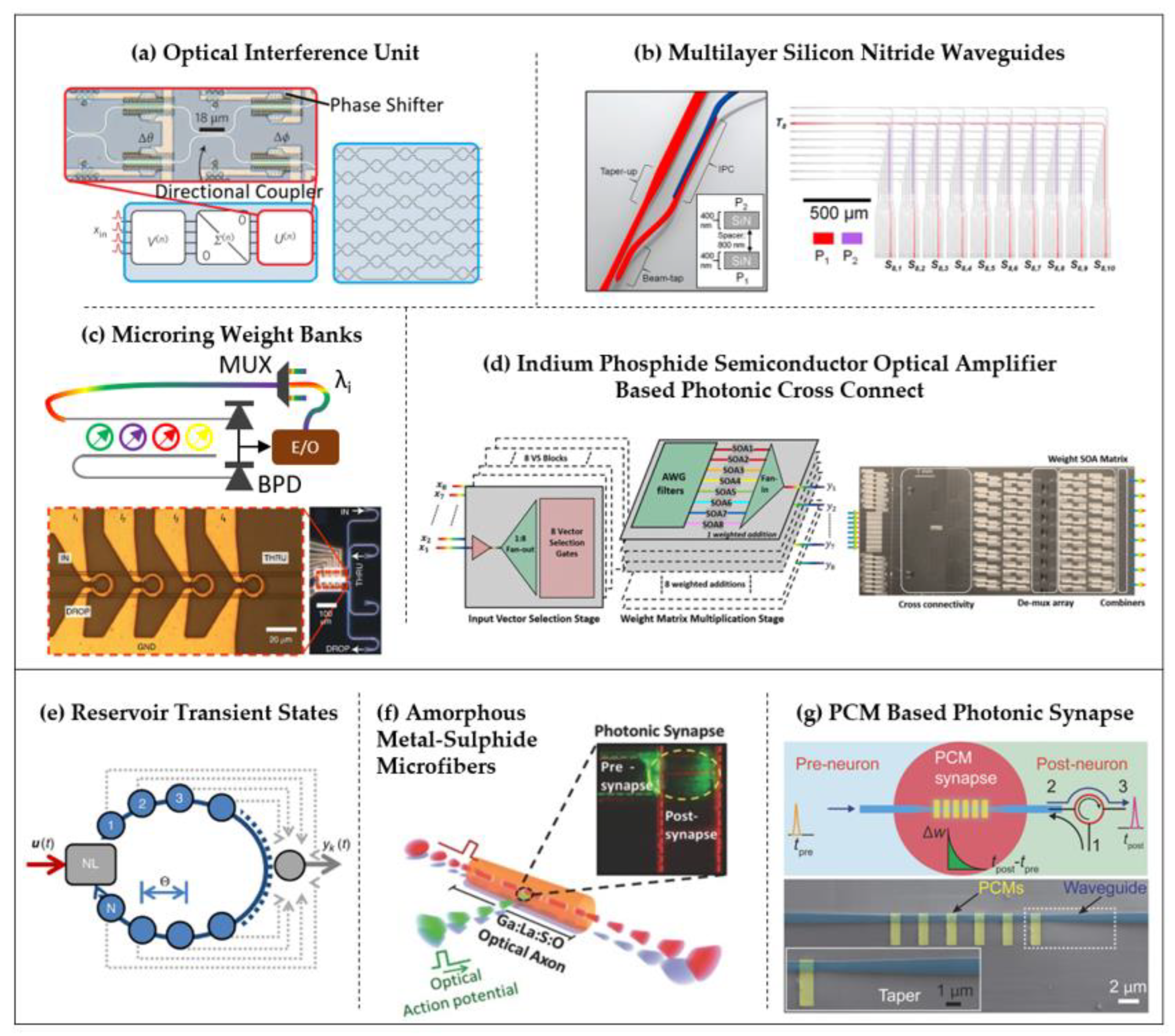
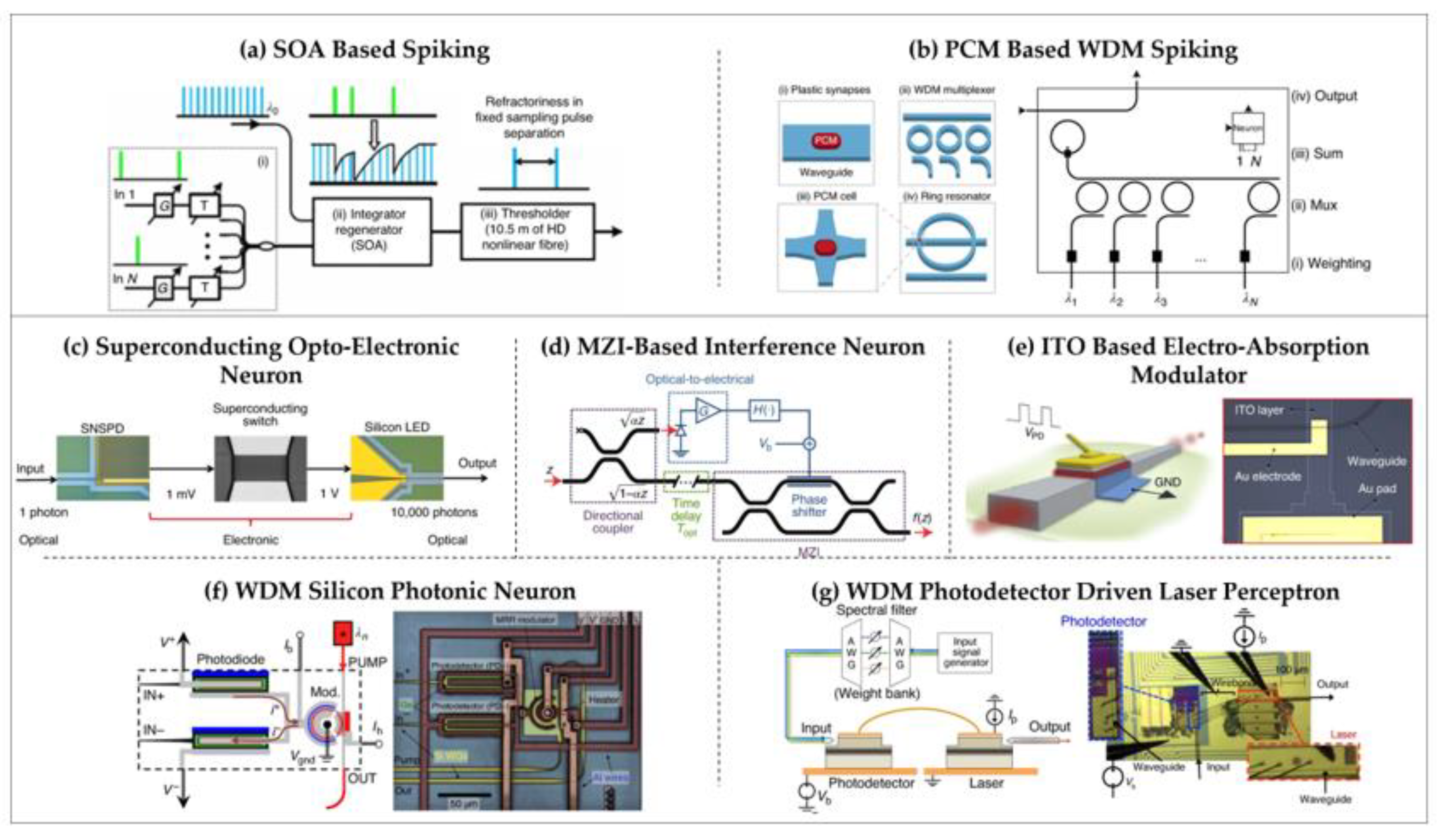
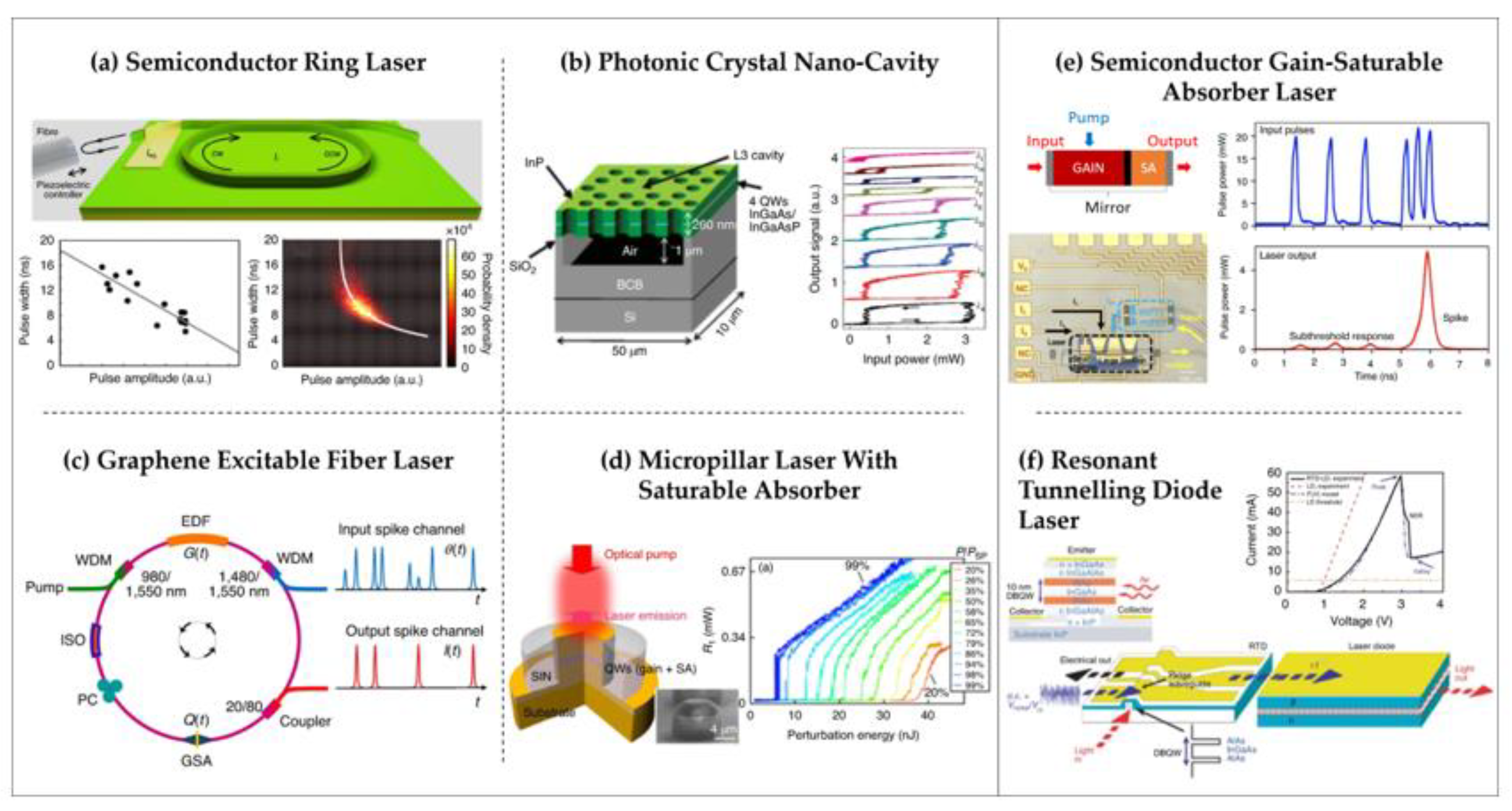
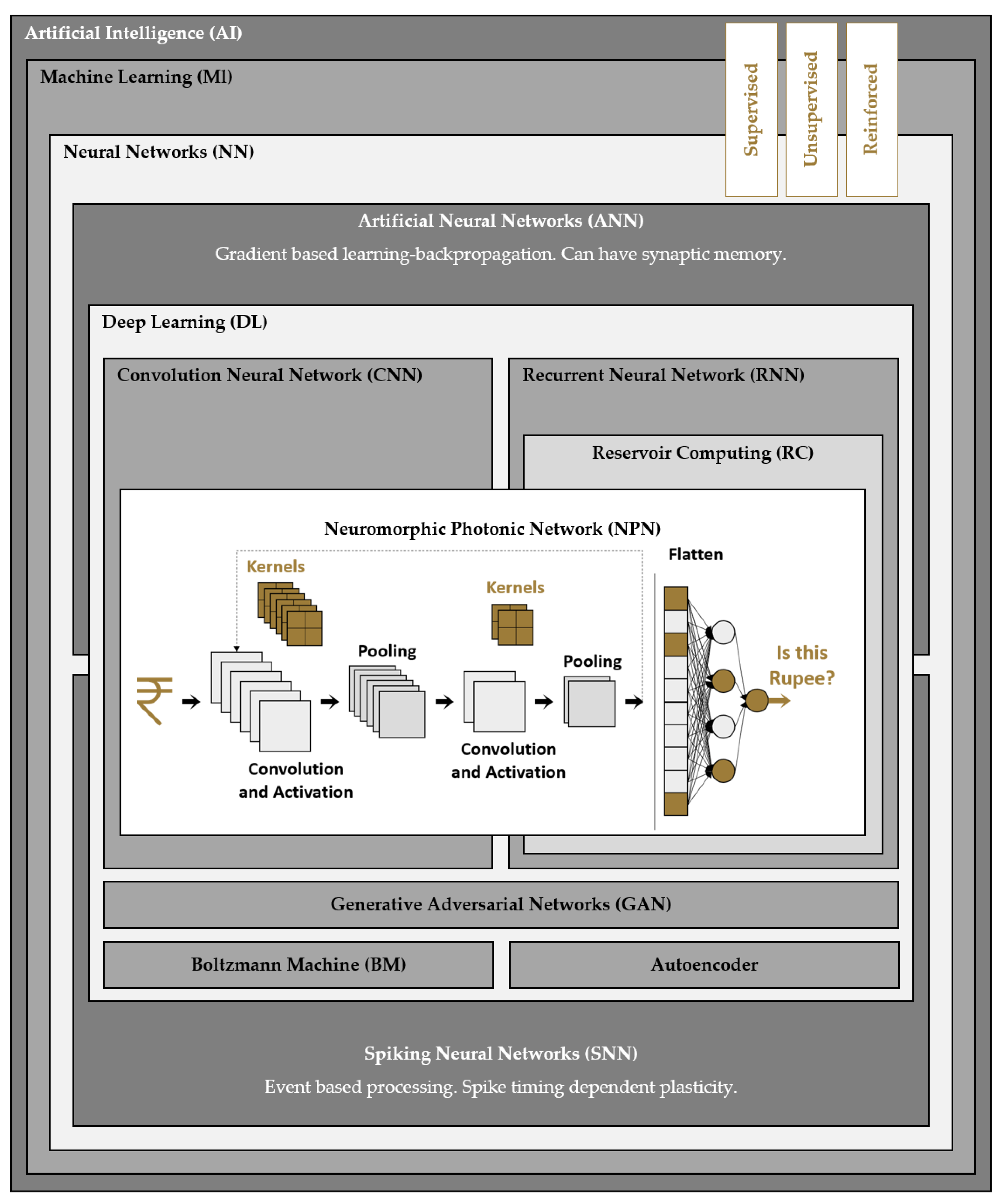
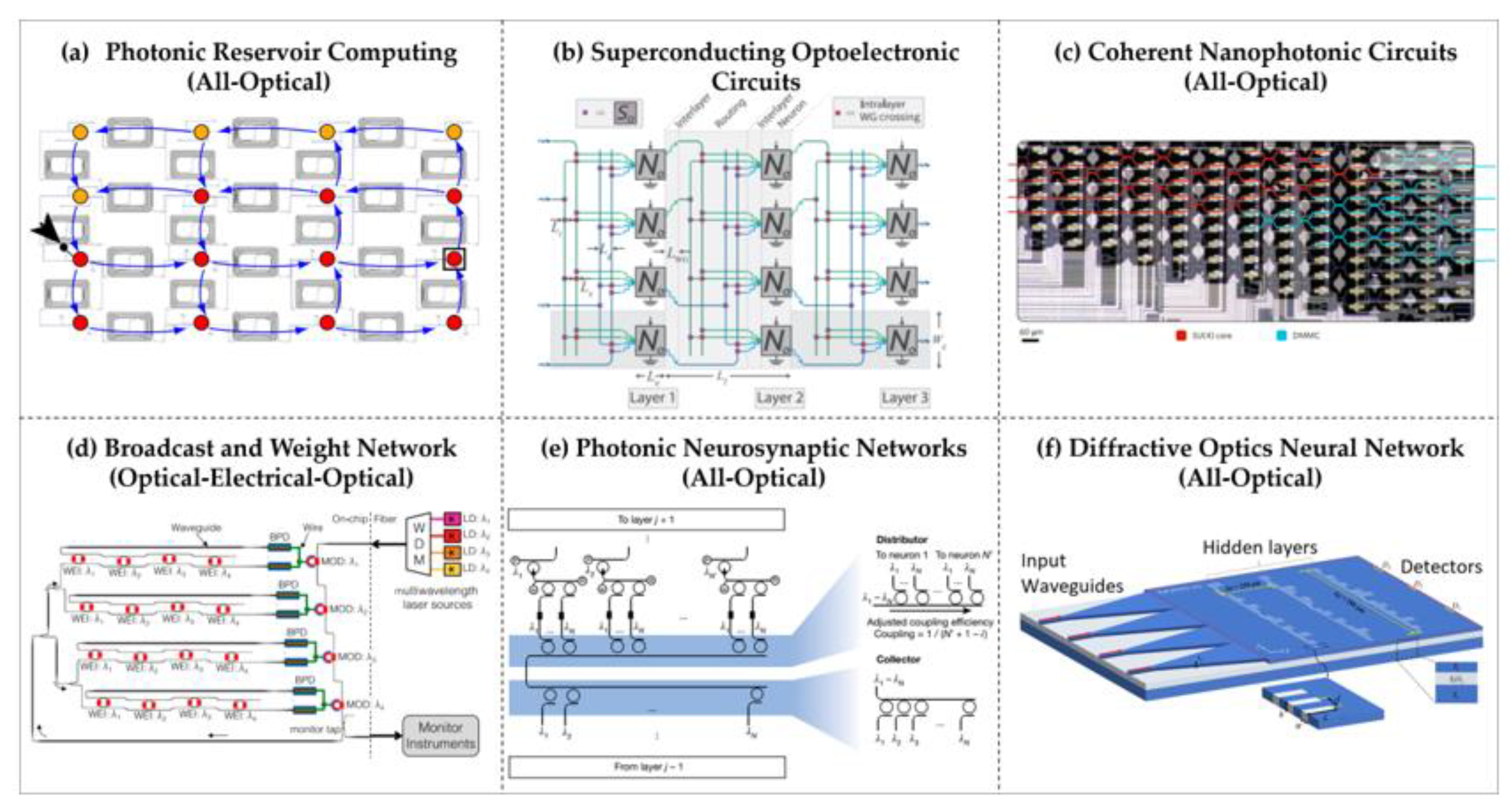
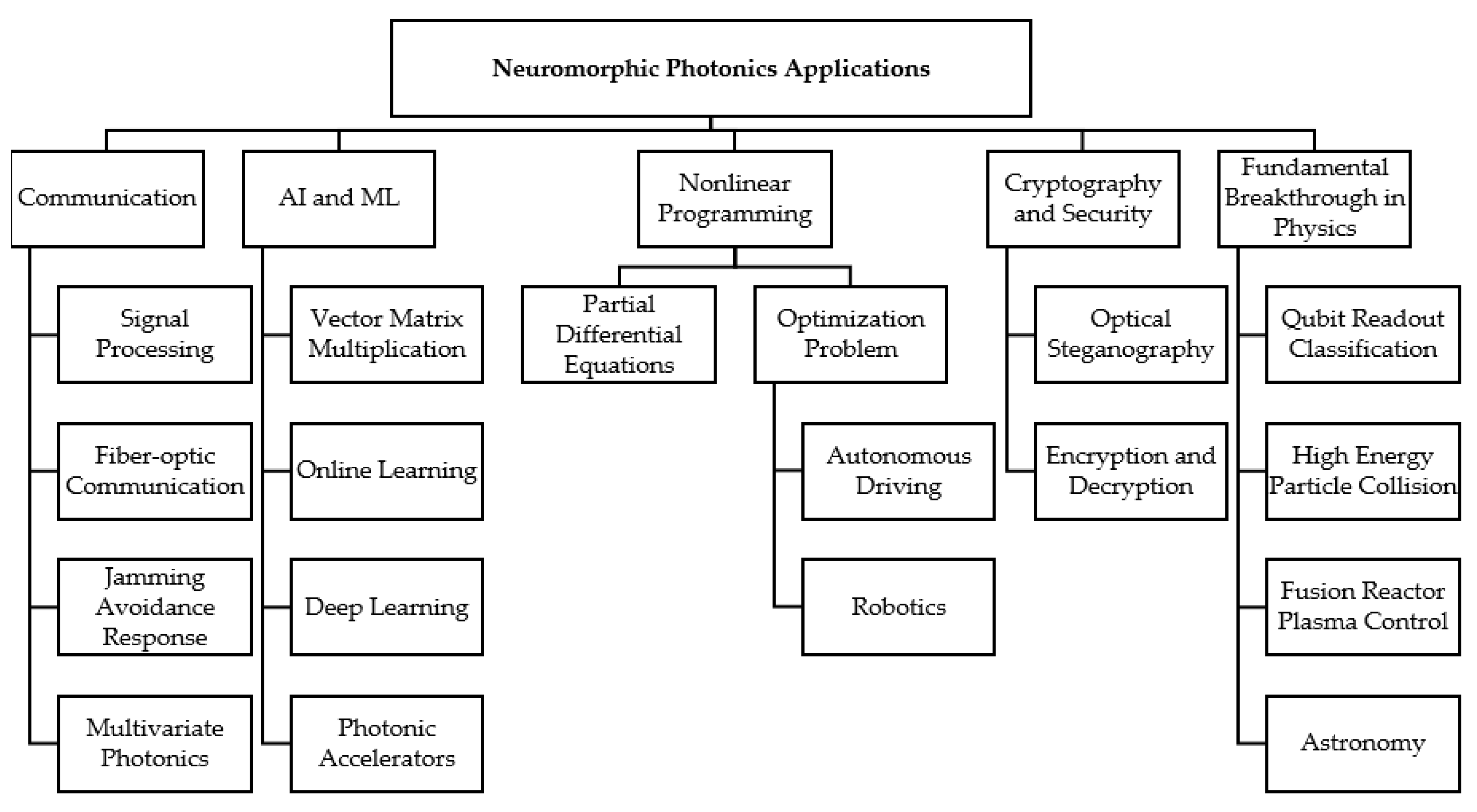
| NPN Type [Ref.] | Synapse | Synaptic Memory | Photonic Neuron | Physics | Topology | Remarks |
|---|---|---|---|---|---|---|
| RC[61] | Node of reservoir with multiple feedback loops. | 280 ps interconnection delay. | Intrinsic nonlinearity of photodetector. | Superposition Principal. | Reservoir |
No power consumption in the reservoir and high bitrate scalability (> 100 Gbit/sec). Cannot be generalized for complex computing application. |
| SOC[111] | Interplanar or lateral waveguide coupler with electromechanically tunable coupling. | MEMS capacitor. | Phase change nanowires from superconducting to normal metal above a threshold induced by photon absorption arranged in parallel or series detector. | Superconductivity and MEMS capacitance. | ANN and SNN |
Highly scalable, zero static power dissipation, extraordinary device efficiencies. Require cryogenic temperature (2K). Bandwidth limited to 1 GHz. |
| CNC[62] | OIU consisting of beamsplitters and phase shifters for unitary transformation and attenuators for diagonal matrix. | NA | Nonlinear mathematical saturable absorber function. | TO-effect. | Two-layer DNN |
Can implement any arbitrary ANN. May allow online training. Bulky and require high driving voltage. |
| B&W[102] | Reconfigurable TO-MRR filters. | NA | Mach-Zehnder Modulator. | TO-effect. | CTRNN |
Capable of implementing generalized reconfigurable RNN. Bandwidth limited to 1 GHz. |
| MN[44] | Optical waveguides integrated PCM on top, controlling propagating optical mode. | GST dynamics. | Optical ReLU designed via MRR-PCM on top. | WDM and PCM dynamic. | ANN |
No waveguide crossings, no accumulation of errors and signal contamination. PCM cell in endurance support up to 10 switching cycles. |
| DO[107] | Pre trained phase values on distinct hidden layers via SSSD. | NA | Diffractive unit composed of three identical SSSD. | Huygens-Fresnel Principle and TO-effect. | Three-layer DNN |
Scalable, simple structure design and all optical passive operation. Requiring external algorithmic compensation. |
| NPN Type | Device Basic Unit [Reference] |
Networks and Training | Comparison | ||||||
|---|---|---|---|---|---|---|---|---|---|
| Topology | Training | Data (Train: Test)% |
Application | Remark or Accuracy Exp. (Sim.) |
NBUs/mm2 | Operational Power (pJ/FLOP) | Throughput (TOPS) | ||
| RC | Spiral Nodes[61] | Reservoir | Fivefold cross validation, ridge regression and winner takes all approach. |
10000 bits for Boolean task and 5-bit headers |
Arbitrary Boolean logic and 5-bit header recognition | >99 (-) | 62500 | 0 | 0.4 |
|
SOC |
SNSPD[111] | ANN And SNN |
Backpropagation and STDP | - | - | Designed for Scalability | 7 to 4000 | 0.00014 | 19.6 |
| CNC | Tuneable MZI[62] | Two-layer DNN |
SGD | 360 data points (50:50) | Vowel recognition |
76.7 (91.7) |
<10 | 0.07600 | 6.4 |
| B&W | TO-MMR[102] | CTRNN | Bifurcation Analysis | 500 data point from 0.05 to 0.85 | Lorenz attractor | B&W is Isomorphic to CTRNN | 1600 | 288.0000 | 1.2 |
| MN | MRR-PCM[44] | ANN | Backpropagation STDP | Four 15-pixel images, A-D | Pattern Recognition | Recognized letters | - | - | - |
| X-PCM[105] | CNN | Backpropagation | MNIST handwritten digits | Digit Recognition | 95.3 (96.1) | <5 | 0.00590 | 28.8 | |
| DO## | SWU [107] | Three-layer DNN |
Pretrained backpropagation (adaptive moment estimation) | Iris (80:20) and MNIST handwritten digits (85:15) |
Classification | 90 (90) and 86 (96.3) |
2000 | 0.00001 | 13800.0 |
| ‡ For more comprehensive information readers may also refer to other reported works [27,96,97,104,117,118,123,124,125]. | |||||||||
Disclaimer/Publisher’s Note: The statements, opinions and data contained in all publications are solely those of the individual author(s) and contributor(s) and not of MDPI and/or the editor(s). MDPI and/or the editor(s) disclaim responsibility for any injury to people or property resulting from any ideas, methods, instructions or products referred to in the content. |
© 2024 by the authors. Licensee MDPI, Basel, Switzerland. This article is an open access article distributed under the terms and conditions of the Creative Commons Attribution (CC BY) license (http://creativecommons.org/licenses/by/4.0/).





